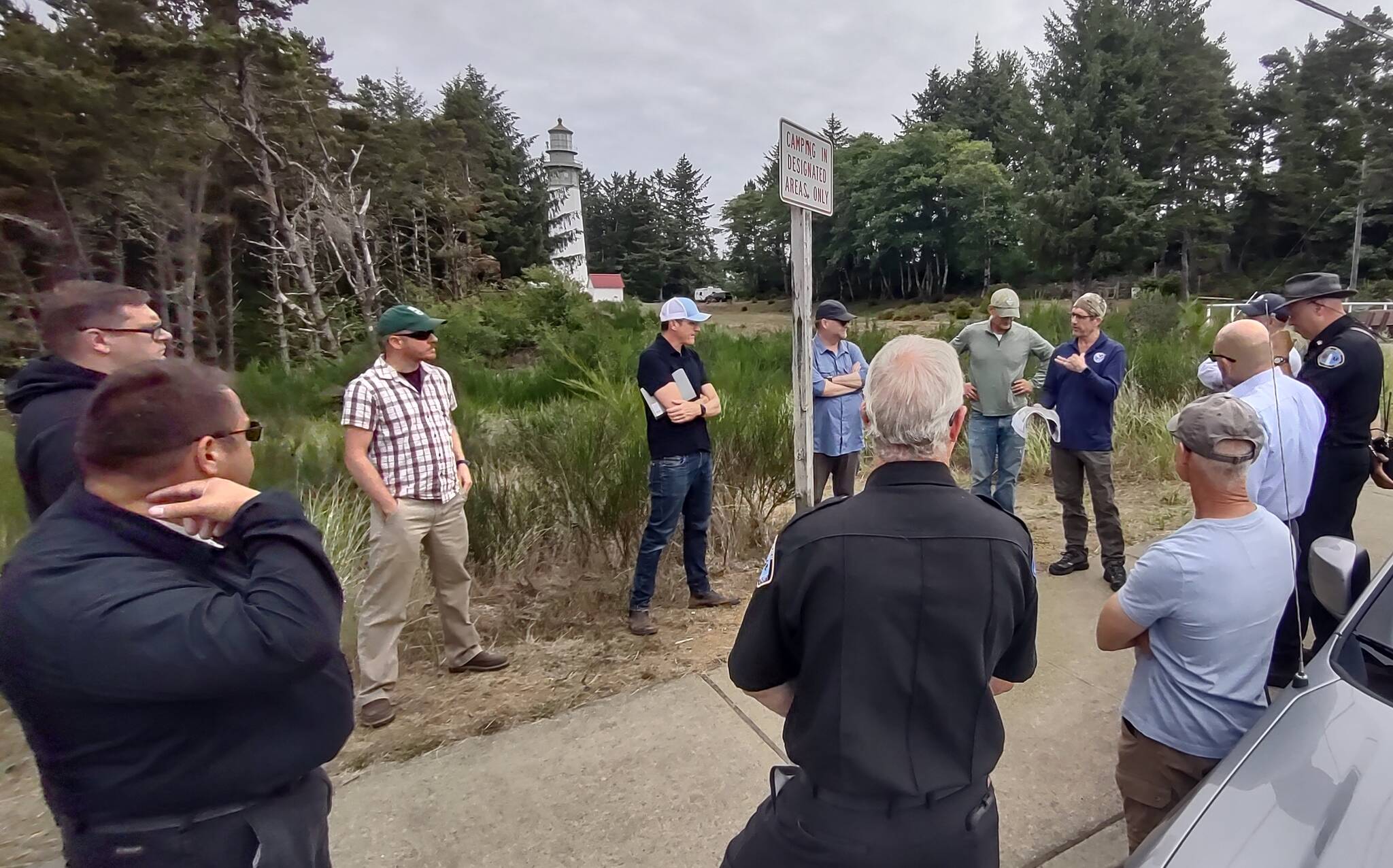On Aug. 10, 2023, city leaders, local and state fire officials, and representatives from the Coast Guard and Washington State Parks gathered near Westport’s historical lighthouse, which separates hundreds of acres of coastal pine forest and the heart of the town’s residential area.
Just two days earlier, a morning brush fire started on the Hawaiian island of Maui, and fanned by high winds, reached the town of Lahaina and burned through it, killing 100 people and displacing thousands more.
An intense wildfire on a tropical island was unexpected for some, but it proved to be a wake-up call for people watching from across the Pacific in Westport, where constant rain and proximity to the ocean sometimes give a false sense of wildfire security as drought becomes more frequent and temperatures rise due to climate change.
“When you think about Lahaina, Westport’s really no different than Lahaina,” said Marc Titus, a community wildfire resilience expert with the Washington Department of Natural Resources. “No one ever thought Maui and Lahaina would ever see anything like that.”
Westport city leaders were already thinking about how to make the city more resilient to wildfire before the devastation occurred in Hawaii. But the timing of that fire, and the likeness to Washington’s original beach town, emphasized the effort.
“We looked at some of our green areas right around Westport and realized we have a pretty large fire risk here if the conditions were right,” City Administrator Kevin Goodrich said at a recent meeting.
Lahaina and other urban wildfires have also left clues for how other towns can save homes and businesses, said Titus, who is helping Westport launch a community wildfire resilience program with funding from the DNR. After the city reached out with concerns about Westport’s vulnerability to wildfire, Titus completed a risk assessment and made recommendations for property owners to reduce the likelihood their structures would ignite during a blaze.
Using that framework, the city aims to become a Firewise USA site, a standard for fire resilience that emphasizes collaboration at the local level.
In the next three months, the South Beach Regional Fire Authority will provide about 50 site assessments at properties while the city will coordinate a yard waste drop-off area and roadside debris pickups as landowners clear away extra leaves, needles, plants — fire fuel — from their lawns and gutters.
Experts say smaller fuels abutting houses, as opposed to towering flames hundreds of feet away, more often result in houses burning down in wildfires.
The Firewise program provides guidelines for managing potential fuels in a series of zones, from next to the house to 100 feet away.
“The solution is ignition resistance,” said Titus, who has helped dozens of cities in Washington with community wildfire resilience since becoming involved with Firewise more than 20 years ago. “That’s what the Firewise USA program focuses on, is helping each and every community member take responsibility for their lot, their piece of the puzzle.”
Some property owners have already taken steps toward resilience, including John Hayes, a former firefighter and board member of the homeowner’s association at the Westport By the Sea condos. Positioned near the beach at the south end of Westport Light State Park, the condos are across the street from the dunes and forest, while landscaping provides a further buffer from fire on the ground.
But the building could still be at risk from blowing embers in a large wildfire.
“You can get an ember that carries into one of the condos, and then if you’ve got that wind and a low humidity day or something, and now your condo has become the fuel,” Hayes said.
Hayes and some neighbors have already cleared out brush and some of the drier plants around the condos in preparation.
Usually, single neighborhoods or homeowners’ associations like Hayes’ would work to receive Firewise acknowledgments on their own. The nearest Firewise area is an HOA on the Long Beach Peninsula.
But because of Westport’s small population size and community cohesiveness, Titus said he recommended incorporating the entire municipality into the program’s area of focus — something unique to only a handful of Firewise sites in the nation.
“That’s kind of cool, for a city like us to go and pursue an effort like this,” Goodrich said.
The DNR will reimburse the city up to $57,000 between April and June 30 for project costs.
Lauren Padgett, a spokesperson for the DNR, said the funding is available because of a series of wildfire bills passed in the state Legislature in the last few years, including one that expanded the DNR’s Wildfire Ready Neighbors program into Western Washington, an outreach program that provides wildfire assistance for landowners and allows the agency to award passthrough grants to efforts like Firewise.
Funding will also go to educational materials and public meetings. With $10,000, the city will hire a contractor to build a landscaped garden at the Grays Harbor Lighthouse property to demonstrate ignition-resistant landscaping.
The project will act as a firebreak on an area of interface between the dunes and forest in the state park and many Westport homes. John Shaw, director of the South Beach Historical Society, which owns and operates the lighthouse, was part of the group who met to kickstart the resilience project there a few days after the fires in Hawaii.
“We had a chance to stand out there and say, ‘hey, two days ago, Maui burned to the ground,’” Shaw said. “It ended up going a really good direction. DNR has been incredibly helpful in trying to bring more national Firewise programs into Washington.”
Contact reporter Clayton Franke at 406-552-3917 or clayton.franke@thedailyworld.com


